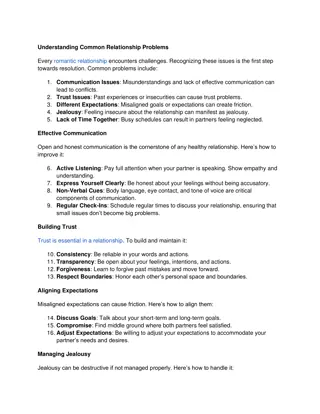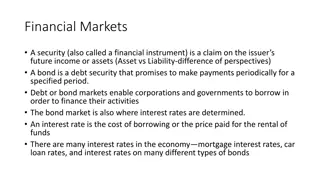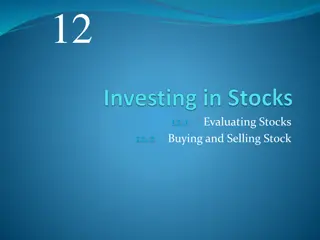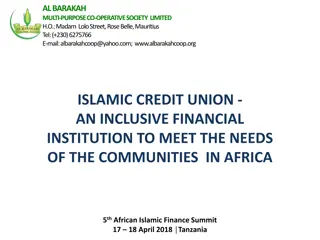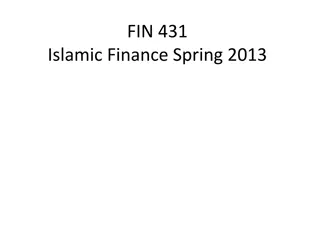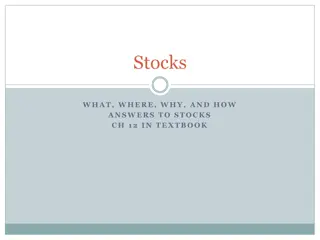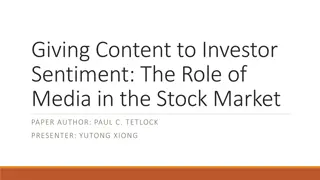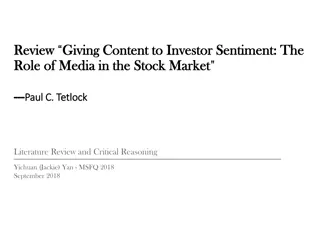
Herding Behavior in Indonesia Islamic Stock Market
Explore the phenomenon of herding behavior in the Indonesian Islamic stock market, where investors often conform to market consensus despite personal beliefs, impacting market dynamics and financial stability. Research findings, literature reviews, and methodologies shed light on this behavior, emphasizing its implications on market volatility and investor decision-making.
Download Presentation

Please find below an Image/Link to download the presentation.
The content on the website is provided AS IS for your information and personal use only. It may not be sold, licensed, or shared on other websites without obtaining consent from the author. If you encounter any issues during the download, it is possible that the publisher has removed the file from their server.
You are allowed to download the files provided on this website for personal or commercial use, subject to the condition that they are used lawfully. All files are the property of their respective owners.
The content on the website is provided AS IS for your information and personal use only. It may not be sold, licensed, or shared on other websites without obtaining consent from the author.
E N D
Presentation Transcript
1 HERDING BEHAVIOR IN INDONESIA ISLAMIC STOCK MARKET Nora Amelda Rizal1, Mirta Kartika Damayanti2 School of Economic and Business, Telkom University
2 Presentation Outline Intoduction Literature Review Methodology Results & Analysis Conclusion & Recomendation
3 Research Background Investors are well informed and act rational. The irrational decisions lead to biases that can affect investor behavior. Herding behavior are characterized by investors who suppress their own beliefs and make investments decisions based on market consensus even though they disagree with the action (Christie and Huang, 1995). Herding behavior in stock market can trigger shifting market prices from fundamental value, aggravate volatility of returns, and destabilized financial markets that may worsen the crisis and increase the fragility of the financial system. Most studies find emerging market tends to make herding and asymmetry herding where investors act differently under different market conditions.
4 Research Background Daily Price JII Daily Price JKSE
5 Research Background JII Market Capitalization
6 Literature Review Authors Findings Methods Chang et al. (2000) find significant evidence of herding in South Korea and Taiwan, the two emerging market in their study find evidence of herding behavior in emerging and advanced market (except US and Latin America). Herding asymmetry is more to be found in Asian markets during upward conditions. find evidence of herding behavior in the Islamic GCC stock market and herding asymmetry is found during upward market condition only. CSAD & Ordinary Least Square CSAD & Ordinary Least Square Chiang and Zheng (2010) Chaffai and Medhioub (2018) CSAD & GARCH
7 Literature Review Authors Purba and Faradynawati (2011) Pangesti and Koesrindartoto (2013) Ramadhan and Mahfud (2016) Putra et al. (2017) Findings Methods CSSD, CSAD, Regression Analysis. CSSD, Regression Analysis CSAD & Quantile regression. CSAD & regression analysis. LSV methods and standard t- test. find the presence of herding behavior in Indonesia composite stocks during normal market uptrend. find no evidence of herding in Indonesia Stock Market. find no evidence of herding in Indonesia and Singapore Stock Market. find the presence of herding behavior in Indonesia and Singapore Stock Market. Zakie and Rafik (2017) find the existence of herding in Indonesia Islamic stock market, either for the foreign or domestic investors.
8 Significant Chang et al. (2000) and Chiang & Zheng (2010) studied herding behavior in emerging market. Chaffai and Medhioub (2018) studied herding behavior in Islamic market. Purba & Faradynawati (2011), Pangesti & Koesrindartoto (2013), Ramadhan & Mahfud (2016), Putra et al. (2017) studied herding behavior in Indonesia market using JKSE. Zakie & Rafik (2017) studied herding behavior in Indonesia Islamic market using the record of buying and selling transaction JII data over period 2011 2016 and analysed using LSV methods and standard t-test.
9 Contribution We investigate the existence of herding behavior in Indonesia Islamic stock market using CSAD method by Chang et al. (2000) which examine the relationship between the market returns and CSAD in non-linear regression specification using GARCH-type models estimation. We use greater frequency and longer observation period by purposing daily data from 2000 to 2018.
10 Research Question Does herding behavior exist in Indonesia Islamic Market? Does herding behavior exist in Indonesia Islamic Market during asymmetry market?
11 Data Daily price data of JII and JKSE from 6 October 2000 to 5 October 2018. Convert daily price stock data to return stock data. JII as individual return JKSE as portfolio return
12 Methodology Cross-sectional absolute deviation (CSAD) [Chang et al : 2000; Chiang & Zheng : 2010; Chaffai & Medhioub : 2018] Divide the data into: Falling market if market return < 0 Rising market if market return > 0 Generalized auto regressive conditional heteroskedasticity (GARCH) Finding the best model among GARCH (1,1) normal, student s, GED, IGARCH, and asymmetry GARCH [Chaffai & Medhioub : 2018]
13 Results & Analysis (General Market) This result align with: Chang et al. (2000) and Chiang & Zheng (2010) find herding behavior in emerging market. Chaffai and Medhioub (2018) find herding behavior in GCC Islamic market. Purba & Faradynawati (2011), Putra et al. (2017) find herding behavior in Indonesia market using JKSE. Zakie & Rafik (2017) find herding behavior in Indonesia Islamic market.
14 Results & Analysis (Asymmetry Market) Falling Market Rising Market
15 Results & Analysis This result did not align with: Chiang & Zheng (2010) that asymmetry herding is more profound in Asian markets during rising markets. Chaffai and Medhioub (2018) that find evidence of asymmetry herding behavior in Islamic GCC stock markets during up market condition only. Purba and Faradynawati (2011) who find the presence of asymmetry herding in Indonesia composite stocks during up market condition only.
16 Conclusion Herding behavior exist in Indonesia Islamic stock market as the coefficient of market return squared was statistically negative. Herding behavior in Indonesia Islamic stock market exist in both market condition (falling and rising). It indicate that investors do not act differently during asymmetry market condition, so there is no asymmetry herding.
17 Thank you










